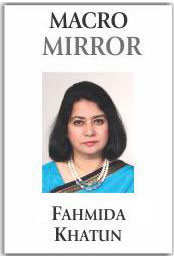If our policymakers want to make Dhaka a sustainable city, there has to be a change in the way they think, the way they plan, the way they take decisions and the way they work.
Published in The Daily Star on Monday, 7 September 2015.
MACRO MIRROR
Dhaka: A sustainable city?
Dr Fahmida Khatun
The annual ‘Liveability Index’, published by the Economist Intelligence Unit, listed Dhaka as the second least liveable city in the world. This recent ranking of Dhaka, among the 140 cities in the world, has once again created a sense of fury and frustration among many of us. The EIU based this ranking on indicators such as stability (violence, crime, terror etc.), health care, education, culture, environment and infrastructure. In order to compare countries against various economic, social, environmental, political and cultural indicators and to determine their relative positions, several organisations take the lead in undertaking such exercise of rankings. It is good to know how a country is performing vis-à-vis others. It is also in a way an eye-opener and can alert countries to take initiatives to do better. If rankings are taken in that spirit, it can be a constructive mechanism for improvement. But that is not always the case in reality. While this gives top performers a sense of feeling good, the bad performers, however, not only get upset but also tend to discard such rankings.
The position of Dhaka on the liveability index is one such indicator which makes us feel excruciatingly dejected. Placed only ahead of Damascus, capital of the war-torn Syria and behind Lagos, capital of Nigeria, and Port Moresby, capital of Papua New Guinea, we are the lone South Asian city to be so far behind in the rankings. Though per capita income is high in both these countries, they rank far below Bangladesh in terms of human development. In 2013, Nigeria ranked 152nd, and Papua New Guinea ranked 157th, while Bangladesh ranked 142nd on the list of Human Development Index of the United Nations. Many have contested this rating and highlighted many good attributes of Dhaka which do not get captured in such rankings. Of course, rankings cannot be perfect as they cannot take into account many qualitative indicators because of quantification problem. Despite such limitations, ranking is now a widely accepted tool for comparative assessment.
But, if the EIU’s rating makes us unhappy, then let’s take a look at another similar ranking. According to an air pollution monitoring report of the World Health Organisation, Dhaka has been ranked 23rd among 1,600 cities of 91 countries with worst urban air quality (2014 Ambient Air Pollution database). In fact, to understand the liveability condition in Dhaka, we do not need any survey. The challenges of Dhaka city and the way they affect the lifestyle of its residents, are probably much deeper than reflected in quantified indicators. Yes, Dhaka as a city (indeed Bangladesh as a whole) has so far been resilient to various shocks. It is a city which has energetic and hardworking people who sail through all odds with astonishing tenacity and perseverance. But it is also a city where people have learned to demonstrate their patience as they get stuck in traffic for hours to get to a destination that is only fifteen minutes away. Waterlogging, from even a short spell of rain, poor sanitation, lack of drainage and sewerage system, and poor emergency services are among many inconveniences that its residents face in their daily lives.
The city is overcrowded. And the crowd is now beyond the carrying capacity of the city. Urbanisation is a natural process and a global phenomenon. Currently, half of world’s population live in cities. By 2050, urban population is predicted to rise to 70 percent of total global population. However, Dhaka’s urbanisation is alarming. Dhaka is the densest city in the world but with so little civic amenities. Though the statistical metropolitan area of Dhaka has increased manifold over the years, so did its population, but at a faster rate. Like all megacities in the world, Dhaka also attracts millions of people from all over the country for better economic opportunities, better education, better health and better quality of life. But a large number of them end up working in the informal sector and living in slums. Infrastructural development and other basic services fall far short of the requirement of the population of the city.
Traffic congestion eats up several valuable and productive hours from human lives each day. Poor air quality increases human mortality and morbidity. The economic cost of particulate (PM10) air pollution in Dhaka city estimated by this columnist in a research is 2.4 percent of GDP of the country. The current model of Dhaka’s growth is thus not economically, socially and environmentally sustainable. This is of course a global concern. It expands from Rio de Janeiro to Beijing to Mumbai. Global leaders, therefore, decided to ‘make cities and human settlements inclusive, safe, resilient and sustainable’ by 2030 (UN SDG 11) through access to affordable housing, basic services, transport system and reducing environmental impact of cities, among other means.
If our policymakers want to make Dhaka a sustainable city, there has to be a change in the way they think, the way they plan, the way they take decisions and the way they work. It is not only about moving away from a car-oriented to a public transport based city but to envision a city hundred years from now. A futuristic view of the political leadership, along with actual implementation, is what Dhaka city needs for its survival.
The writer is Research Director at the Centre for Policy Dialogue, currently a Visiting Scholar at the Centre for Study of Science, Technology & Policy, India.


